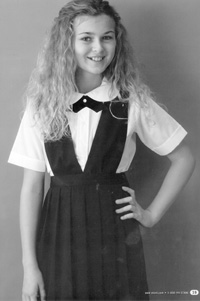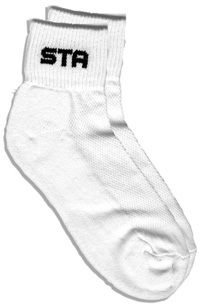|
By Beth Silver, With more public, private and parochial schools looking to expand their school uniform programs, retailers of all sizes need their school uniform sales programs to make the grade. Whether you are a retailer looking to carry school uniforms for the first time or a long-time uniform retailer, following this top ten list will ensure that your school uniform program is on target. 1. Have a Strategy. Begin to think about what type of school uniform retailer you want to be and who your customers will be. Will you cater to the public or private/parochial school market? Will you carry school uniforms year round or just at back-to-school time? Do you want to be a retailer who will be on hand to discuss how a program may affect a school or who will just carry goods? Will you sell your school uniforms in a retail store or on the Internet, or both? Successful school uniform retailers know who they are and who they want to be, and they dont try to change that. 2. Know the Market. Research school uniform programs in your area and learn who can help you. Understand what types of school uniform policies exist in your area. Do the public school districts in your area require school uniforms and, if so, are the programs mandatory or voluntary? What types of programs do the private and parochial schools have? What process does each type of school use when it comes to school uniform programs including how the uniforms are selected and how they are offered for sale to the students? If public schools require school uniforms, be sure to attend school board and Parent Teacher Association (PTA) meetings to learn what your community is looking for in a school uniform program. At these meetings, you will show your civic interest and meet those parties involved in the decision making process. Then, when the time arises, you will be known as an active participant in the school uniform conversation. If private schools require uniforms, learn about their programs. What has been successful for them, and what would they like improved? Are there specific garments required for certain grades and schools? Are contracts awarded, and if so, when are the requests for proposals extended? Are pre-orders given, and if so, when? 3. Know Your Customer. 4. Have the Right Product & Selection. When choosing a school uniform manufacturer, be sure to ask what styles and sizes they carry and what is their year-round availability, as this will affect your retail program. Do they use treated fabrics such as StainSmart by Milliken or Teflon which are known to prolong the life of a garment and cost more than products that are not treated? Lisa Phrommer, North American manager for Teflon Fabric Protection, reinforces the importance of stain-resistant treatments. Our research has shown that parents are willing to pay more for products treated with Teflon, as it prolongs the life of the garment. Teflon sells its technology to uniform manufacturers such as Levinson Textiles, Elder and Lollytogs, as they cater their products to different markets. Donald Singer, president and CEO of Executive Apparel, makers of Elite School Apparel, knows that his merchandise is better suited for private schools. For the most part, we dont deal with public schools. Their uniform needs are very generic. We deal with private and parochial schools that demand a more formal look and expect a higher level of quality control. We specialize in blazers, pants, ties and blouses and dont make golf shirts, T-shirts or work pants. This specialization means that our customers find us when their needs are very specifically geared to the higher end of the clothing spectrum. Andy Beattie, general manager of Classroom School Uniforms, knows that Classrooms products are mostly worn by public school students. The Classroom line is known for its vast selection of uniforms, the sizing available, our StainSmart and stretch merchandise, and that our products fit within most school uniform programs. From preschool to high school, our customers know that Classroom will help make their program a success. 5. Create Effective Partnerships. The Manufacturer. Its a partnership. If I succeed, they succeed. They want to make me a success, and I appreciate that, says Dorothy Moore, owner of Moore Seigler Sports World in Shreveport, La., speaking about her two most helpful uniform partners, Classroom School Uniforms and Elder Manufacturing. They are my experts. They educate me on what they are seeing in the market nationwide and how I can improve my business. We understand what our retail partners need to improve their business, and we deliver, adds Classrooms Beattie. Classroom School Uniforms has launched www.classroomuniforms.biz to provide retailers access to their inventory in real time, 24 hours a day, seven days a week. We just completed our first survey of National School Board Association members so that our retailers have the most up-to-date information on the topic of school uniforms in public schools. Executive Apparels Singer credits his companys success to providing superior service combined with diligence, response time and integrity. The Schools and Community. Other Retailers. 6. Location, Location, Location. You may consider extending your hours during back-to-school time to allow for the rush of new uniform needs. If an on-site sale is possible through the school, you may need traveling garment displays, fitting rooms and sales registers. The investment in such items will likely pay off in the number of sales. 7. Staff Training. Manufacturers agree that great service is the key to success in most venues today. In a fast-moving, demanding environment, not all companies can adapt and change with their customers needs. For Talia and Danielle Goldfarb, co-owners of Myself Belts, staff energy and training is vital to success in certain retail stores. Myself Belts new product allows younger children to take off their belts with one hand, something sales staffs cant highlight if they arent aware of the special design. When our retailers train their staff on our products and they are excited about it, more of our belts are sold in their store. 8. Evaluate the Shopping Experience. John Livingston of Hermann-Livingston says, Servicing the students and parents is important. We are thrilled to be able to provide our Toledo customers with a store that provides them more options. Last year, when we worked with Toledo Public Schools, we set up uniform days one Saturday a month for each school. Now, parents and students will be able to find what they need six days a week. We created larger dressing rooms so both parents and students experience greater comfort. 9. Advertising & Marketing. 10. Review and Reevaluate your Strategy & Program. If you would like to contact Beth Silver with questions or comments, she can be reached at [email protected]. |
|
| Above story first appeared in MADE TO MEASURE Magazine, Spring & Summer 2006 issue. All rights reserved. Photos appear by special permission. | |
|
Halper Publishing Company |
|












